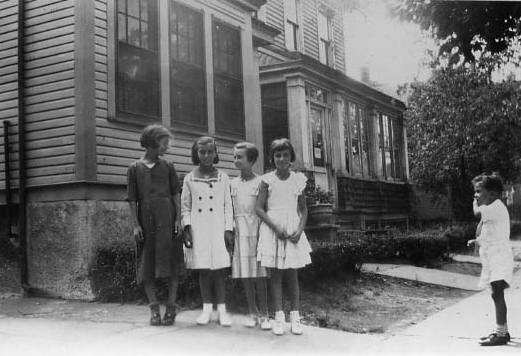
Figure 1.--We do not see American chidren commonly wearing ankle socks until the 1930s. This family snapshot looks to have been taken about 1940. Note the porches. |

|
Three-quarter socks were common in the 1910s, but we rarely see ankle socks. We first see them orominently after World War I in the 1920s. With the rapid decline of knickers in the late-1930s and early-40s, ankle socks became increasingly common for boys. We even begin to see boys wearing ankle socks with knickers. We see them worn as casual as well as dress up hosiery. American boys wore them with shot pants suits as well as for casual events and play. At first ankle socks were highly seasonal, but gradually became the standard hosiery worn by boys in all seasons. A factor hereof course is that boys began to icreasingly wear long pants. We do not see ankle socks in the early-20th century. We do not even commonly see them in the 1920s. They appeared in the 1930s and by the end of the decade were quite common. We notice girls wearing them as well. Our assessment, at least for boys, is somewhat complicated by the increasing popularity of long pants. While we can easily see the hosiery worn with short pants and knicjers. It is much more common with long pants. Normally the ankle socks we see at first were striped socks. We note colored rings or argyl patterns. We note girls wearing solid colored socks, especially white socks, but this was less common for boys. White athletic socks became very popular for boys after World War II, especially in the 1950s. A good example is a birthday party in 1956. They were commonly worn by boys wearing short pants, but also long pants as well. I am not sure why white socks became so popular. They were so popular that mothers often to fuss at their sons when they dressed up so they wouldn't wear white socks with a suit.
With the rapid decline of knickers in the late-1930s and early-40s, ankle socks became increasingly common for boys. We even begin to see boys wearing ankle socks with knickers. We do not see ankle socks in the early-20th century. We do negin to see them in the 1920s. They became common in the 1930s. A good example is a class of Ohio kindergardeners in 1935-36. By the end of the decade, ankle socks were the principal hosiery boys were wearing. We even see boys wearing ankle soicvks with knickers.
We see them worn as casual as well as dress up hosiery. American boys wore them with shot pants suits as well as for casual events and play. We note the Tucker boys in 1937 wearing ankle socks with Eton jackets and white shorts.
At first ankle socks were highly seasonal, but gradually became the standard hosiery worn by boys in all seasons. A factor here of course is that boys began to icreasingly wear long pants. Thus long stockings and knee socks were not as important for warmth.
We notice girls wearing ankle socks as well.
We notice boys wearing ankle socks with short pants, knickers, and long pants. Our assessment, at least for boys, is somewhat complicated by the increasing popularity of long pants. While we can easily see the hosiery worn with short pants and knickers. It is much more common with long pants. They were commonly worn by boys wearing short pants, but also long pants as well.
Normally the ankle socks we see at first were striped (colored rings) socks. We note colored rings or argyl patterns, but the colored rings were by far the most common. The backgroundand rings were done in a wide variety of colors. The strioed socks were more common for boys than girls, but they were worn by both genders. There were no age conventions associated with this striped socks, boys of all ages wore them, but not adults. We are mot sure why these ringed patterns became so common for ankel socks. Long stockings were motly solid colors. Knee socks were commonly a varirt of patterns, but not stripes (rings). Why these three major types of socks have different patterns associayed with them we are not sure.
We note girls wearing solid colored socks, especially white socks, but this was less common for boys. Boys as ankle socks began to become importnt in the 1930s commonly wore dark socks. Striped socks were common in the 1950s. A reader writes, "I remember the colored ankle socks. I remember sometimes my feet would have the color of the socks on them after a day of playing and sweating in them. I was glad (looking back) when wearing white socks was more
acceptable and that issue disappeared." White athletic socks became very popular for boys after World War II, especially by the 1960s. For every day wear there were inepensive cotton socks, not real atlletic socks. A good example is a birthday party in 1956. I am not sure why white socks became so popular. They became so popular with boys that mothers often to fuss at their sons when they dressed up so they wouldn't wear white socks with a suit.
Navigate the Boys' Historical Clothing Web Site:
[Return to the Main U.S. hosiery type page]
[Return to the Main ankle sock page]
[Introduction]
[Activities]
[Biographies]
[Chronology]
[Clothing styles]
[Countries]
[Topics]
[Bibliographies]
[Contributions]
[FAQs]
[Glossaries]
[Images]
[Links]
[Registration]
[Tools]
[Boys' Clothing Home]
